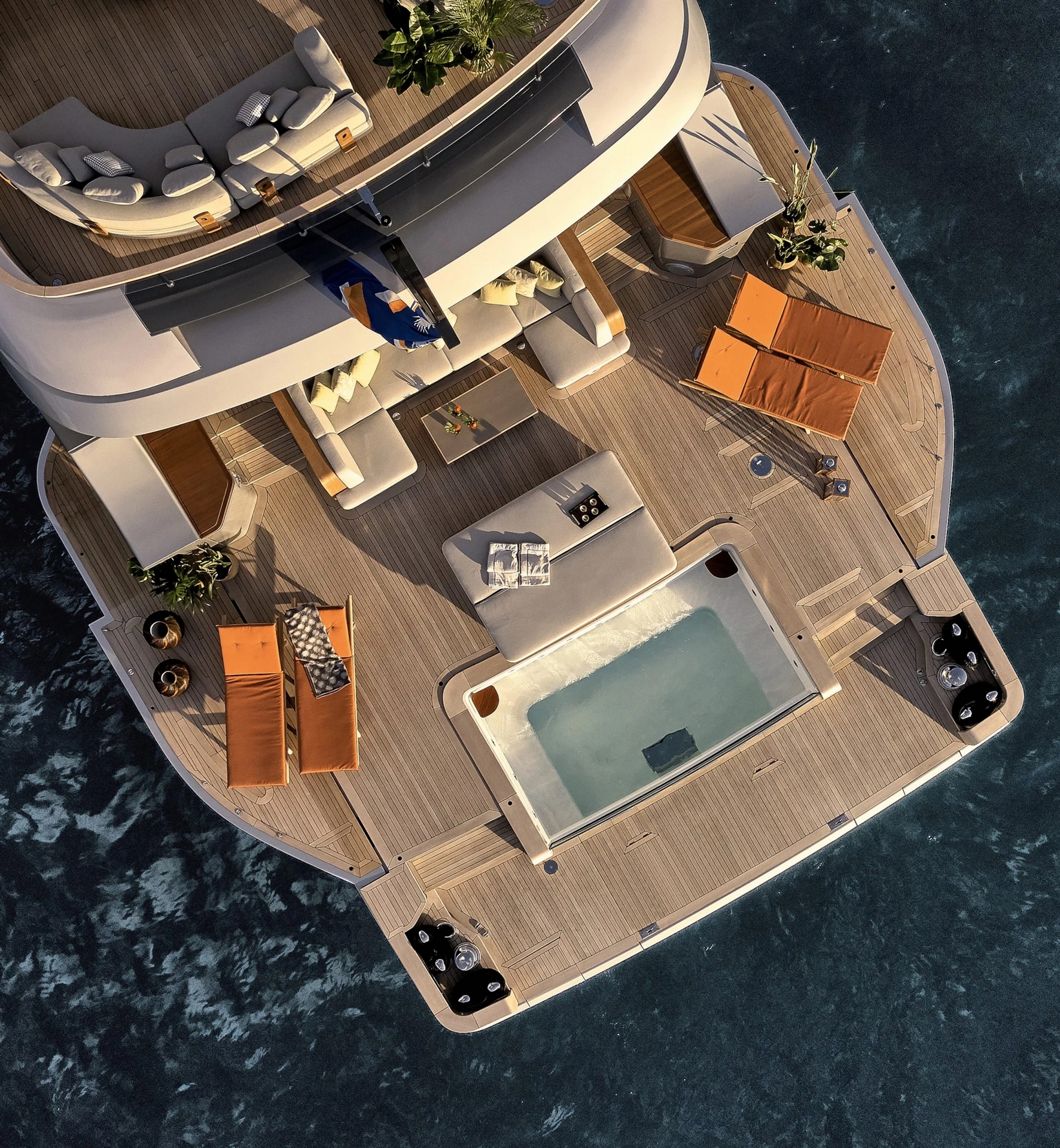

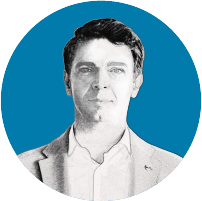
A year of MAXIMA
Interview with
Fiorenzo Spadoni,
Marine North Europe Region Senior Director, RINA
RINA continues to focus on superyachts with MAXIMA: its new brand dedicated to large yachts.
With more than 1,100 yachts under class, RINA remains the leading classification society in yachting. Already in the early 2000s it launched a dedicated service line - the first to follow sustainability guidelines – as well as a unit devoted to yachting. RINA was the first classification body to not only train personnel dedicated solely to this sector but also to develop class rules for megayachts for private and commercial use back in 2005.

With more than 1,100 yachts under class, RINA remains the leading classification society in yachting.
Since October 2022, RINA has decided to take a further step forward in this segment - particularly in the largest sizes of superyachts - which has grown exponentially in recent times. In fact, according to market intelligence data, in 2022 alone some 174 new yachts between 40 and 180 metres were sold (compared to 128 the previous year, and 72 in 2020), adding to a fleet of pleasure vessels that has now risen to a total of 5,902 units. A further 1,500 will be added by 2030.
With this in mind, the company has launched RINA MAXIMA: a new brand dedicated to custom built steel/aluminium yachts. The brand has been created to provide all players in the sector with a structure comprising the people, skills and services needed to meet the challenges of the future, particularly in terms of decarbonisation and digitalisation.
MAXIMA has a team ready to offer a portfolio of tools and services to ensure clients are always at the forefront of the market; the team’s work, specifically, focuses on innovative design approval techniques, sustainability and decarbonisation, digital solutions, core services such as noise and vibration activities, while strengthening collaboration with the major flag administrations.
The objective of RINA - which is also a reference point in the world of cruise ships, a segment which is often close to superyachts - is to transfer experience and know-how from other sectors, accompanying its partners and guiding them in the implementation of new technologies and innovative solutions.
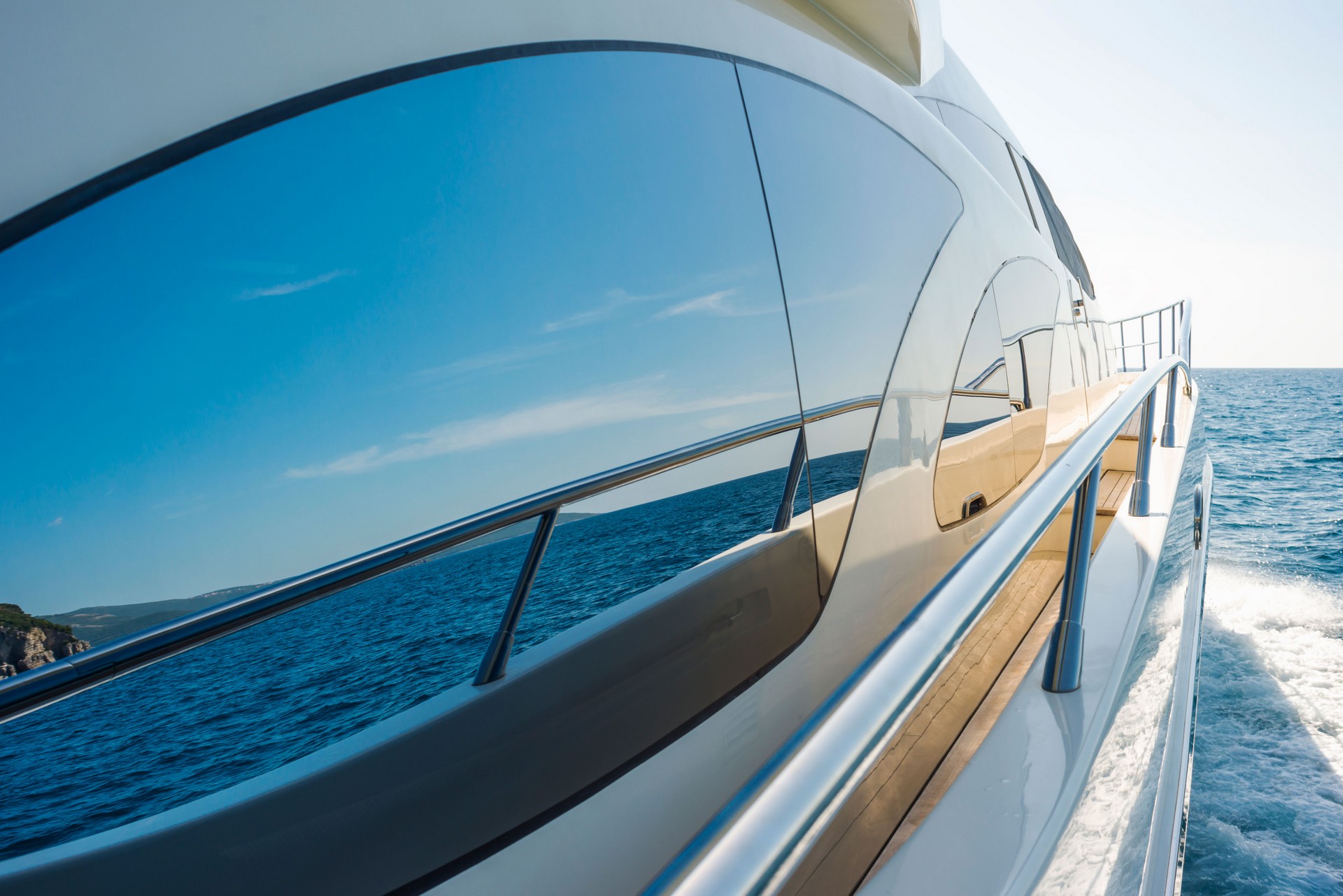
One year after launch, we can say RINA and Maxima are fully in line with the sustainability goals the shipping industry has set for itself: decarbonisation is an objective which requires a multidisciplinary approach taking into account technologies, materials, fuels, infrastructure and digital tools.
In this respect, RINA is supporting the superyacht sector not only by providing regulations and guidelines for the use of alternative fuels such as hydrogen and methanol, but also providing engineering support through risk analysis and feasibility studies while also acting as a solutions integrator. Today, these two fuels, together with bio-fuels, are the most promising candidates for achieving zero emissions, especially when coupled with fuel cells.
RINA MAXIMA also includes the new “sustainable yacht” notation, the first to assess both environmental and social elements. This notation is goal-based and includes in its scoring system the GREEN-PLUS, COMF LARGE YACHT, DOLPHIN YACHT and MLC DESIGN notations. Most notably, there is also a carbon intensity index to measure carbon dioxide emissions while at sea and in port in line with the IMO CII index for merchant vessels. All these elements form a sustainable framework covering all aspects, from pollution to wellbeing and comfort on board, right down to the noise emitted underwater by the vessel to protect marine fauna.
During this year several projects have been enhanced by RINA MAXIMA, not only as part of the decarbonization challenge, but also through its digital solutions, most of which are embedded in our yacht management software SERTICA YACHT.
Designed to improve reliability and safety, Sertica Yacht offers a real-time system to plan and manage onboard work efficiently, supporting operators, shipyards and management companies in their efforts towards achieving sustainability, while still emphasizing the use of data to improve vessel design and operational efficiency. Our digital package includes planned maintenance, fleet management, a digital twin and performance monitoring capabilities tailored to the yachting sector.
RINA MAXIMA aims to become an instrument for the industry to develop solutions to the complex challenges of the future. For this very reason, it is continuously evolving, featuring new tools and services to remain at the cutting edge of innovation. Stay tuned for the next developments!
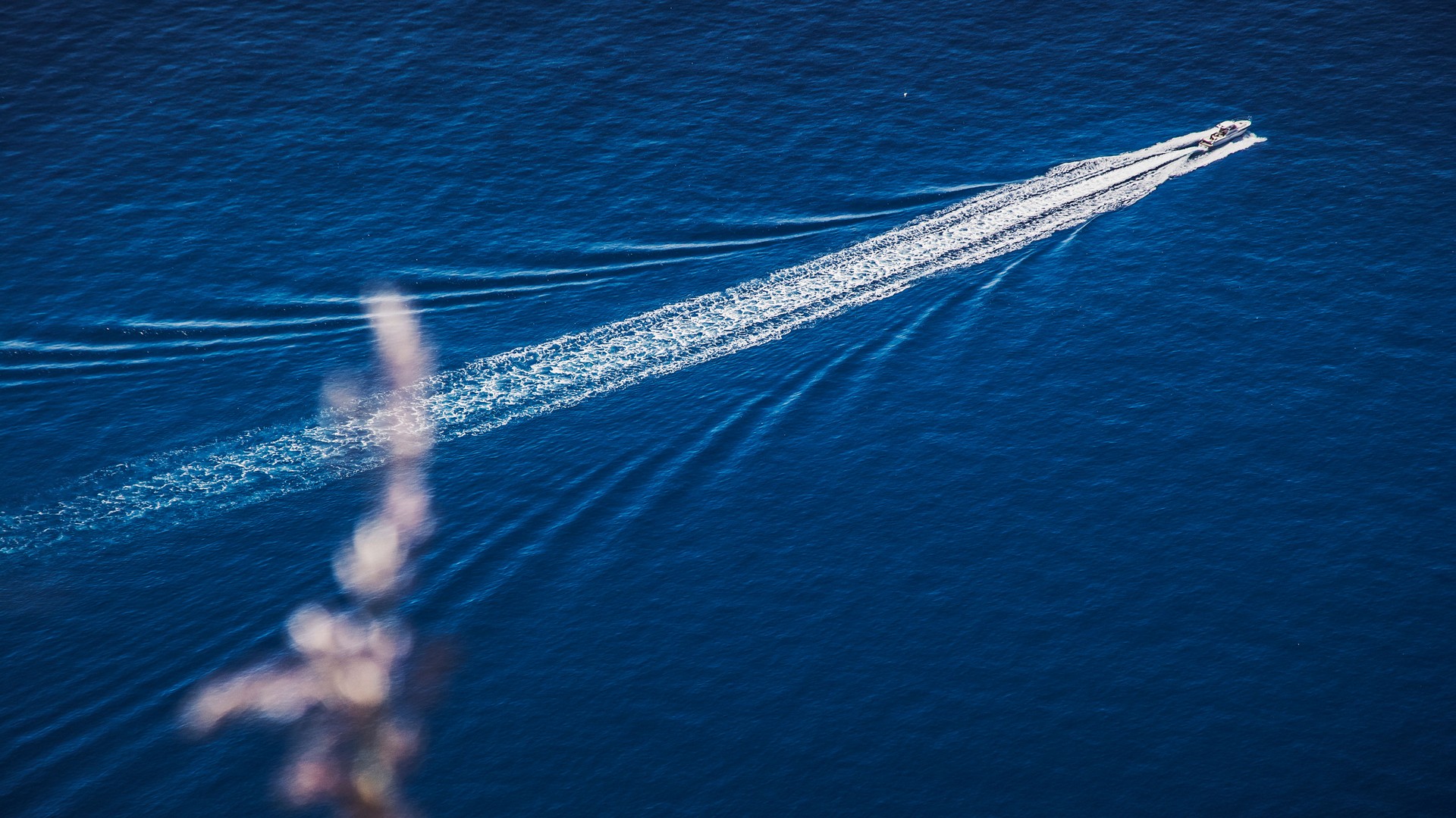
Interview with
Michelangelo Casadei,
Chief Technical and Operation Officer of Nautor Swan and General Manager of Oy Nautor Ab

Michelangelo Casadei graduated as a Mechanical Engineer from Bologna University in 1999 cum laude. He began his professional career in 2000 at the Fiat Group, working in product development of diesel engines in several divisions and countries. In 2008, he joined the Ferretti Group, initially working on product industrialization and modularization, before taking the lead of the group’s Quality, Testing & Deliveries in 2011. In 2015, he became Engineering Director during the group’s successful relaunch plan where he, with his engineering team, developed and launched-to-market 30 new models under its different brands (Ferretti Yachts, Custom Line, Riva, Pershing and Wally).
In 2021, Michelangelo became the Chief Technical and Operating Officer of Nautor Swan, working directly with the CEO Giovanni Pomati on the company’s transformation and growth. He has focused on the Boat Technology Center Yard in Pietarsaari (Finland), the expansion of the Club Swan racing boats range, and the new Power Boats division start-up and growth.
Michelangelo is a keen sailor and has taken part in many international events, including the transatlantic Quebec-Saint Malo, the Rolex Middle Sea Race, the Copa del Rey, and many others.
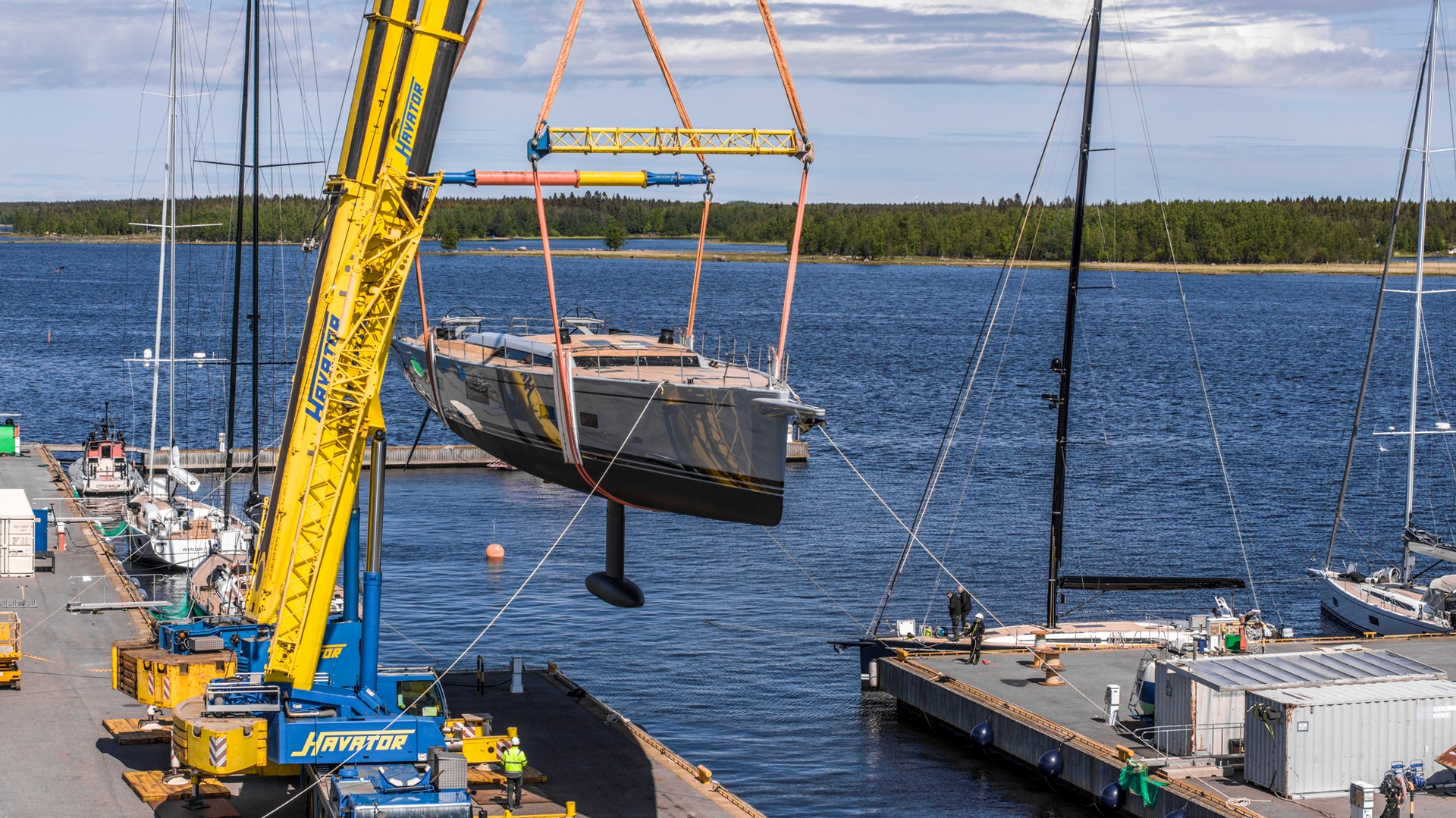
COVID-19 provided another boost to the yachting market following the growth seen in 2015-2020. It has attracted a large number of new clients to boating, and we note an evolution in the buying patterns of customers.
At Nautor Swan, which is best known for its world-class sailing yachts, we are seeing a trend that is also apparent in other industries: a slight slowdown in demand for low- to mid-range products but notable growth at the other end of the scale, that is, in the maxi range above €8 million.
Customers’ expectations are also growing in regard to living spaces, onboard comfort and perceived quality. This has rendered long-term investment in technology, know-how, digitalization and sustainability more crucial than ever.
Nautor Swan’s sail boats also dovetail with the most vital issue at the moment: sustainability and the environment. What could be more low impact than a sail boat? We have been focusing on sustainability for a while now through our “Green and Blue” approach to products and their usage. This means adding green technical features to our blue water performance cruisers.
Today, we are providing technical “packages” to help owners save even more energy: this includes better hull efficiency, improved ventilation, efficient air conditioning and thermal and noise insulation. We are also helping owners to recover CO2-free energy through solar, wind and hydrogeneration, which is applied to hybrid electrified yachts, both for “hotel” use (when the boat is at anchor with the generators switched off), and propulsion.
At the other end of the equation, we are focusing on creating ‘wise’ mission profiles that avoid overloading yachts with large battery banks, which despite their evolution in recent years, are still rather inefficient, heavy, expensive and not really eco-friendly over their life time. We strive to provide a ‘rational’ rather than emotional or ‘fashion oriented’ approach to hybrid propulsion.
We place great importance on R&D into new energy sources, such as hydrogen and ethanol fuel cells, and other sources that are able to take us beyond batteries, which can then be reserved as a useful and minimized energy buffer. We carry out R&D in cooperation with renowned Universities, including Politecnico di Milano and Università di Bologna, who we supported for the second year running at the recent Monaco Yacht Club Energy Challenge.
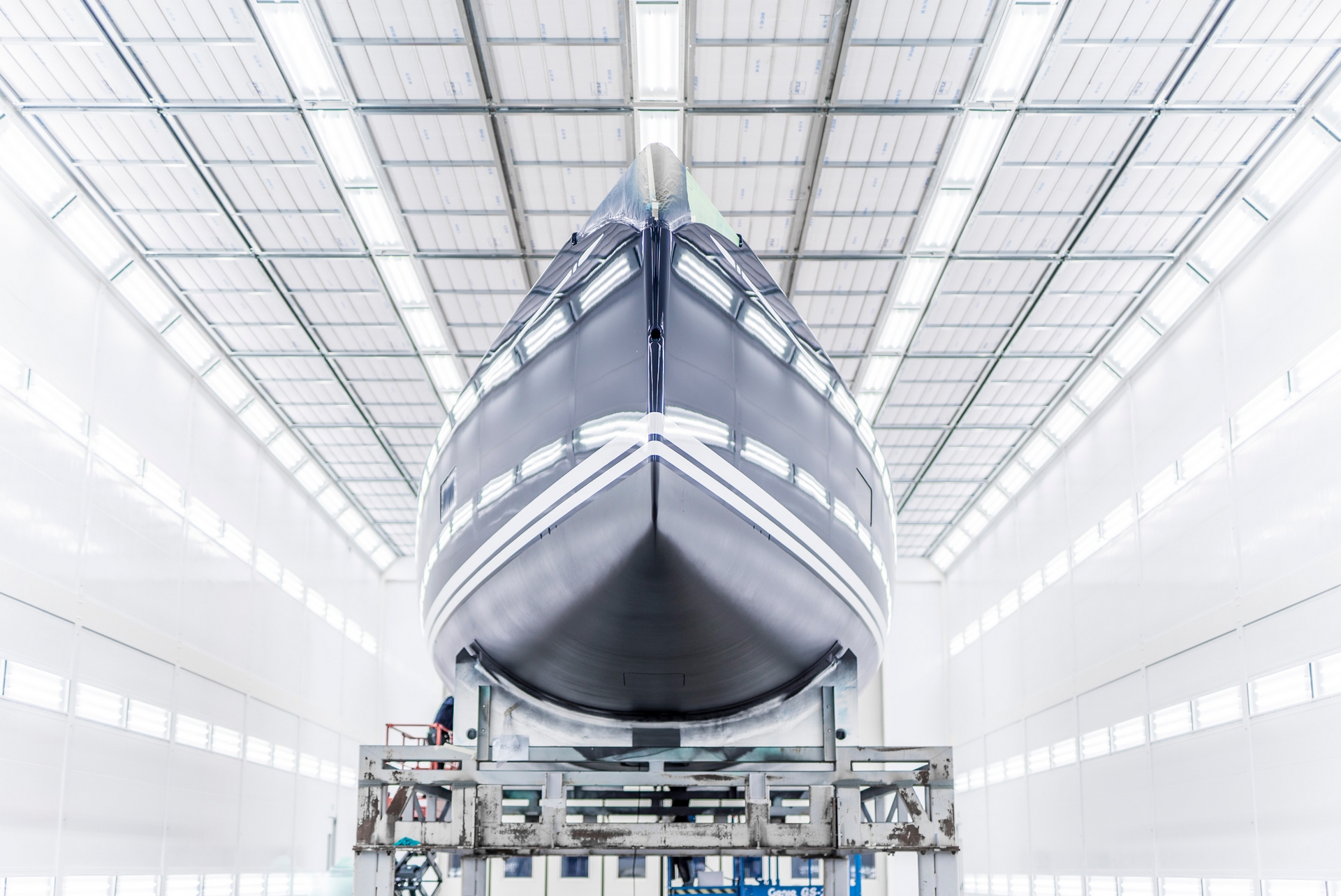
Our new Maxi Swan 88 series is an example of this overall philosophy, and the first unit will be launched in 2024. This sail boat will feature full electric propulsion assisted by batteries and high-density generating sets, including hydrogeneration capability. We are making the series scalable, with a full OEM approach that will also be applicable to the smaller Swan Line yachts, right down to the 48 feet models.
Another area where we are improving sustainability is in our production chain, and our goal is to enhance our processes through lean methodology. This starts at our shipyard, the Boatbuilding Technology Center in Pietarsaari, Finland, where we re-use heating and energy from other industries, improve transport and material flow, optimize working hours per manufacturing line to optimize our environmental footprint, and above all focus on people engagement.
We are also working on new materials to improve the performance and comfort on board. Air and water appendages, such as foils and sail wings, are becoming increasingly common in the niche area of performance yachts. It is likely that these will eventually spread to ‘normal’ yachts only if their ease of use improves and owners are able to sail in comfort without a compromise in layout and general arrangements.
There is also a lot of technology in terms of materials, live monitoring and control functions (sailing and load auto-optimization and aids, for example) that could, and will, be progressively transferred to performance cruisers. Remote connectivity can also play an important role, with proper infrastructure behind.
Throughout all of these developments, RINA is at our side. We have been increasingly working with RINA in recent times, and see the real added-value when our shipyard’s Technical and Certification Team receives complementary help, understanding and motivation from RINA’s surveyors and technical functions: that is, moving from “checking a project” to “jointly optimizing a project”.
Being able to exploit regulations to build yachts that are safe, seaworthy, and compliant, but also better in innovative functionalities, design and aesthetic features is a priceless tool. Here again our new Maxi Swan 88 series is a prime example, where we have been able to offer extra length and living volume to owners and crew, while keeping the load line length of the unit below 24 meters.
Interview with
Marcello Maggi, Chairman of W-Fin Sarl, the sole shareholder of Wider

Marcello Maggi started his career at CRN in 1986, subsequently becoming Sales & Marketing Manager. During this time, he helped facilitate the merger of the shipyard with Ferretti Group, as well as its later successful IPO.
Marcello was one of the founders of ISA Yachts in 2001, which became one of the world’s top players in the yachting industry, developing an international reputation with its world-renowned yachts.
In 2013, Marcello left the company and founded MMYB (Marcello Maggi Yachting Boutique), a Monaco-based consultancy firm assisting clients in every aspect related to yachting.
In 2019 he acquired 100% share capital of
WIDER with the vision of expanding the Company and the focus of building
electric and hybrid yachts and passenger units. As of today, Marcello is one of
the Founders, Shareholder and President of W-Fin Sarl, the holding Company that
owns 100% of Wider equity.
Today, we can really see that an attention to the environment has arrived in the yachting industry: clients are more and more sensitive to this issue, as shown by Wider’s experience with our new-state-of-the-art catamaran, the WiderCat 92. We have sold 5 of these new yachts without yet having a hull in the water, demonstrating the market’s interest in this niche product. Here, the challenge was to combine sustainable technology with an attractive, futuristic design.
Backed by commercial know-how of our team, we carried out extensive market research which shows this segment offers great promise for the future. Catamarans offer two strong advantages: an implicit increased living area, and greater attention to sustainability factors including reduced fuel consumption and less noise and vibration. We believe this yacht type will enjoy widespread success going forward.
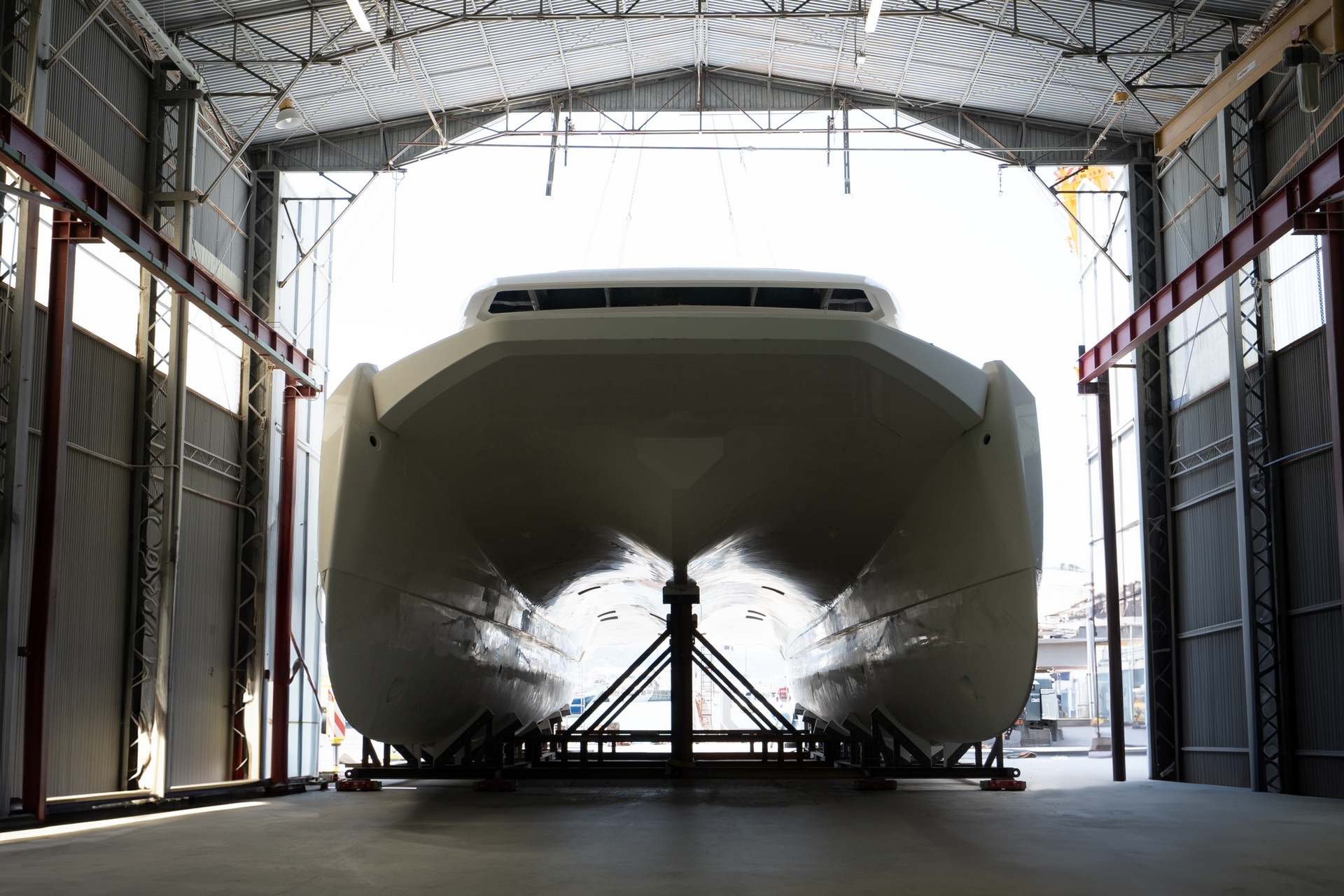
Environmental concerns are at the centre of a second important project at the yard, the Moonflower 72. This yacht will feature our pioneering serial hybrid propulsion system, a trademark of the yard, and will allow for a substantial reduction in environmental impact. The serial hybrid propulsion system comprises two variable-speed generators of 1,860kW each, and a sodium nickel battery bank of approximately 1MW. Considerable attention has been paid to the recovery of energy dispersed in the form of heat from the electrical propulsion system.
Meanwhile, the operation of onboard amenities has been optimised to increase efficiency and reduce consumption by using AI to automatically learn and adapt to the habits of owner, guests and crew. The yacht also comes equipped with multiple solar panels that will allow on-board energy generation.
Moonflower 72 is our masterpiece and together with Nauta Design, which developed and created the exterior and interior lines of the yacht, we are working hard to complete each step of the project in order to wow the market in 2025. Don’t miss it!
Wider’s core business is without doubt innovating in the “green” space in order to enhance and maximise sustainability at every stage. We began working on a serial hybrid propulsion system many years ago when this technology had yet to be widely accepted in the market. Today, we have enhanced our technology and are constantly searching for new ways to make improvements. This ranges from new methods to cut harmful emissions, to paying attention to where our materials are sourced, and finding new technologies which respect the environment - everything that helps the environment while making it possible to use the yacht in total safety.
We are committed to blending the latest innovations and technologies in harmony with the sea and its environment.
This raises interesting questions for future staffing: with the increasing use of technologically advanced components such as the electric and hybrid propulsions, now more than ever there is a need for highly qualified captains and crew.
This is needed both at a mechatronic level, and in Information Technology (IT), where the latter is also increasingly present in yachts. It remains important to support yachting academies, as well as the important Masters courses and professional schools for technicians.
From a commercial point of view, we now see the start of a normalisation in the market, which, however, is still showing considerable positivity and elan! After the sharp increase in activity over the past two years, the return of some calm to the market is normal but we still see plenty of demand and dynamism. Political events are worth keeping an eye on, however, if we are to avoid the risk of sudden crises.
As far as Wider is concerned, we are happy with what we have achieved so far in terms of orders, both for our superyacht production in Venice and for our brand-new production facility in Fano. We are comfortable that we are on the right track, particularly given the increasing demand for more and more sustainable yachts.
RINA provides an important boost to our activities and is a reassuring presence as we move to develop increasingly complex technological solutions. RINA’s team of professionals are always available and ready to help find solutions for even the most awkward technical issues.
We see our collaboration as the ultimate “problem solver”, with RINA’s technicians working in tandem with our engineering and production departments to resolve issues quickly and efficiently, while always safeguarding the safety of the boat.
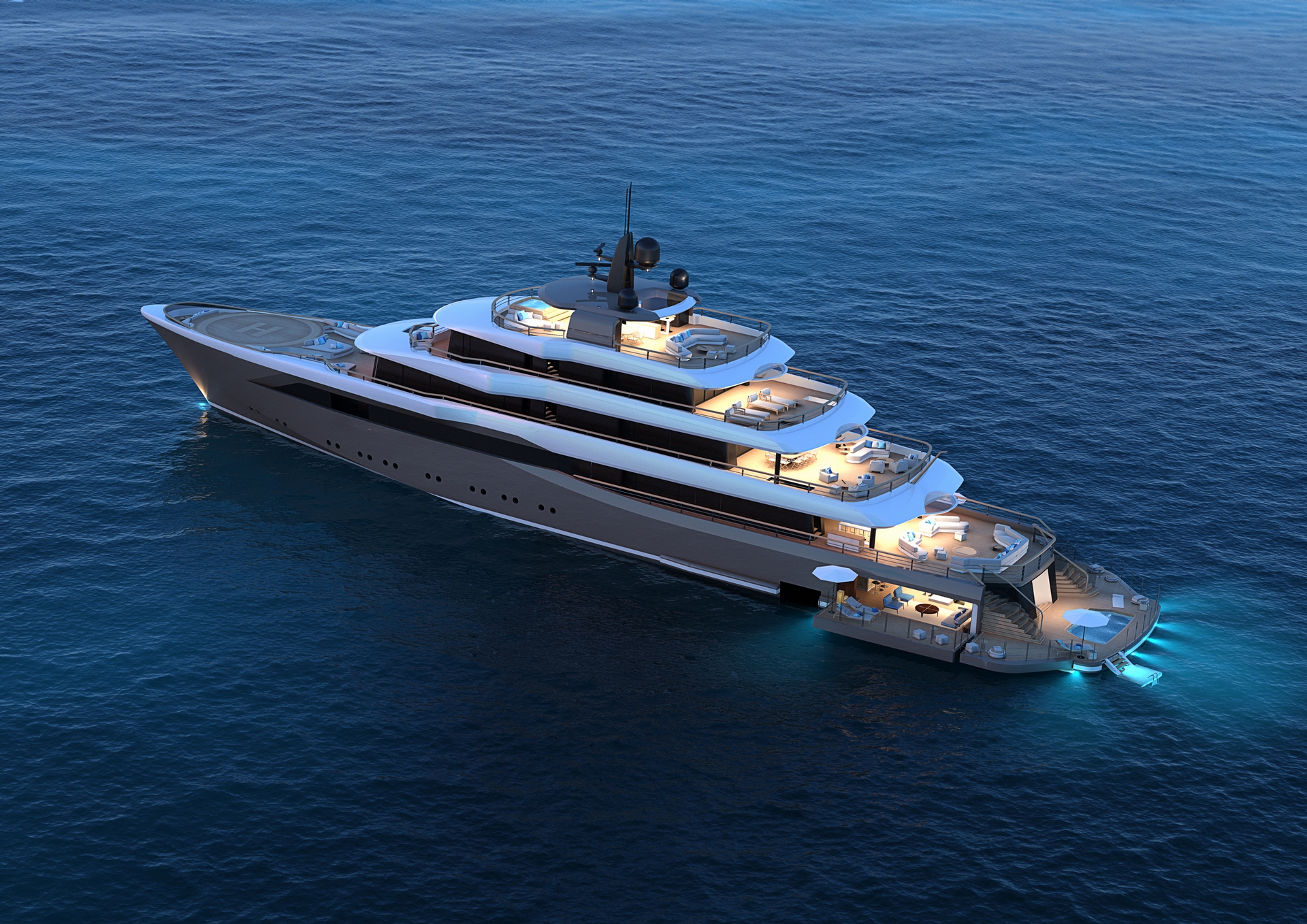
Interview with
Stefano de Vivo, Chief Commercial Officer of Ferretti Group

Stefano de Vivo graduated in Naval Architecture and Ocean Engineering from the prestigious University College of London and gained an MBA from the University of Sciences and Technology in Hong Kong.
His nautical career began at Riva where he started as Project Manager, before becoming World After Sales Manager and later Greater China and Asia Pacific Manager. He subsequently joined Benetti as Sales & Marketing Director and Vice President of Sales, while continuing to consult for top international groups in fields from fashion to automotive with a specific focus on the Asia Pacific market.
In June 2014, Stefano was appointed as Ferretti’s Group Chief Commercial Officer where he has strategically co-managed the sales department of CRN, the Group’s brand specialized in designing and building true-custom yachts up to 95 meters. In January 2019, he was appointed Managing Director of Wally Yachts following its integration into the group’s portfolio.
The yachting industry is constantly expanding, and it is becoming increasingly clear, especially in this ‘post-pandemic’ era, that new needs and trends have been created. Yachts are seen more and more as ‘private islands’ of freedom and safety, where most of the time on board is spent with guests.
Ferretti Group is a true leader in this and, as such, is always working to offer its customers the best possible product. In the short term, the yachting industry is trying to meet needs, mainly related to the issue of sustainability; in the long term, there will be other challenges that will keep the industry alive and continue to fuel its growth.
The emergence of a new generation of yacht owners, however, brings with it heightened awareness of and concern for sustainability. This new group of owners, predominantly younger individuals, is increasingly focused on environmental responsibility and the impact of their actions on the planet.
These owners are actively seeking ways to minimize their carbon footprint, reduce waste, and preserve the marine environments they sail through. They are inclined to invest in eco-friendly yacht designs, hybrid propulsion systems and renewable energy sources like solar panels to ensure a greener yachting experience. Sustainability is not just a buzzword for them, but a genuine commitment that drives their choices and influences their perception of the industry.
We all have a duty to care for the environment, and Ferretti Group has long been on a virtuous path to minimize its environmental footprint, and we are determined to continue in this direction to promote increasingly sustainable boating. We were the first operator in the yachting industry to publish a Sustainability Report, a decision rooted in our awareness of the multiplicity of stakeholders who interact with us and of the importance of their needs and expectations.
This year, Ferretti Group published its third Sustainability Report, confirming our commitment in this area. We work to reduce our environmental impact both before and after delivery, focusing our efforts on reducing the weight of our hulls and therefore energy consumption, on the search for alternative and sustainable materials, and on research into hybrid and electric engines.
Digitalization and the integration of new technologies into the yachting industry are also expected to have a profound impact on the market. With advancements in artificial intelligence, data analytics and the Internet of Things (IoT), yacht owners and operators can benefit from increased efficiency, enhanced safety, and improved user experiences.
Our brand CRN is investing in a new concept of megayacht with high-level technology. Innovation is inside CRN’s DNA: in 1983, CRN designed and built the first diesel electric true explorer vessel in the pleasure yachting world, the 32.8-metre F100 for the head of Fiat Group Gianni Agnelli. Designed for long voyages in all weather, it was the first with floating rubber supports, a type of soundproofing that presaged the active noise cancellation technology developed 20 years later.

Today, CRN is in the vanguard of research into hybrid propulsion, emissions reduction, efficiency improvement and sustainable technologies, as well as into new weight-reduction systems to make our shipyard operations more efficient too. This is where our IMO Tier III certification comes in – CRN was the first shipyard in Italy to achieve it – along with the trigeneration plant installed in Ancona to produce clean electricity and heating/cooling energy.
Elsewhere the group continues to grow with the recent acquisition of a new 70,000 square metre production site, including a dry dock, in San Vitale in the province of Ravenna. Ravenna is the right production centre for Wally sailing yachts and the expansion of our other brands, starting with the extraordinary Ferretti Yachts INFYNITO and new wallywhy ranges. The operation is part of Ferretti Group’s growth strategy, and when fully operational the new plant will increase production capacity.
Throughout we expect to be accompanied by RINA, with whom we have worked for many years. In fact, the Group was one of RINA’s first yachting clients. We have collaborated extensively from the outset, especially on very large luxury yachts, in a relationship that has always been synergetic.
One example of this is our co-development of a regulation to apply to electric boats, one that does not exist yet, using RIVA’s El-Iseo - the first full electric powerboat prototype, packed with technology and innovation - as a benchmark.
This for us is the most effective demonstration of how RINA is one of the most important certification body in the world, and how we work together in an open and synergetic relationship to improve regulations for luxury yachts, making them increasingly safe for guests, crew and the environment.
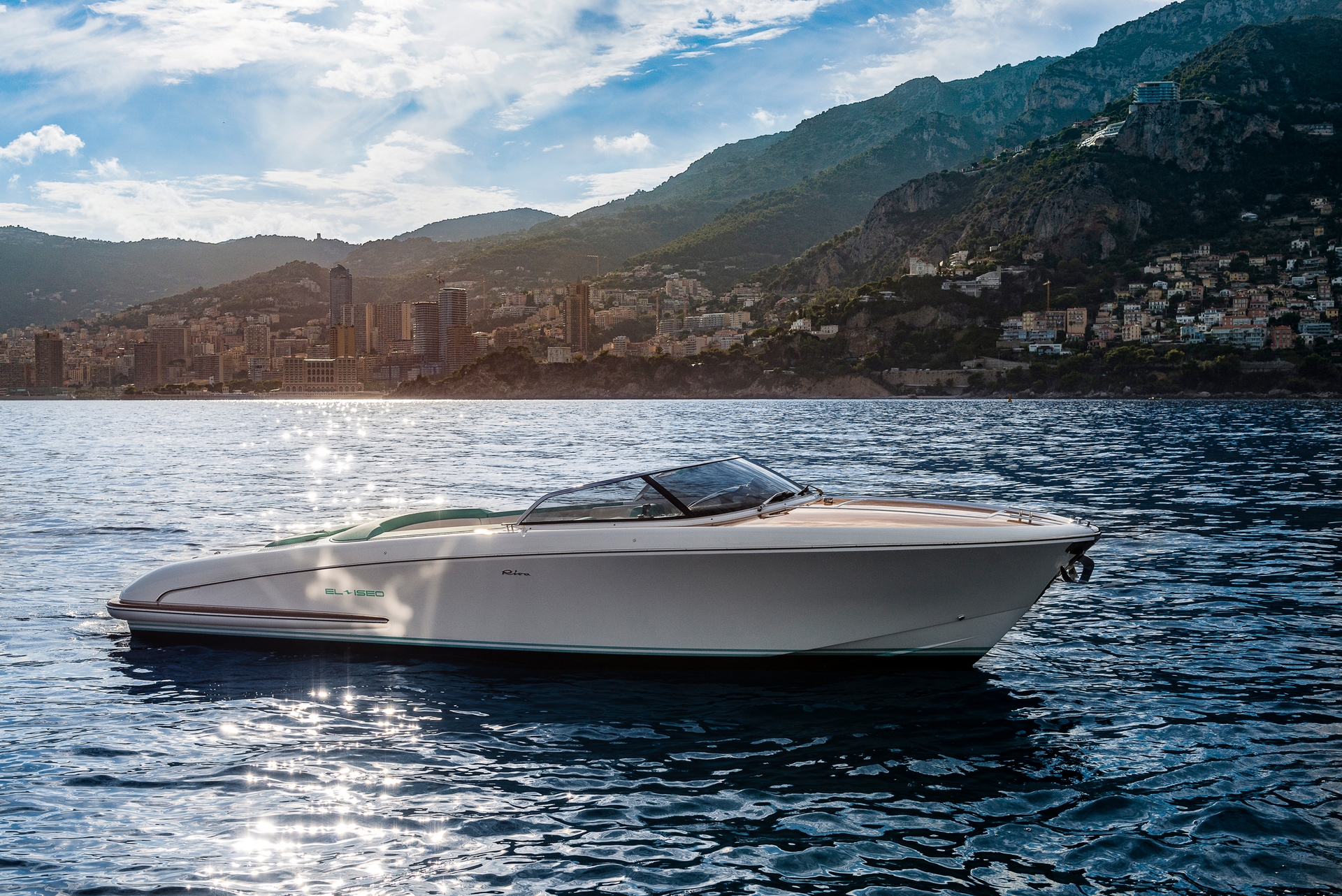
Interview with
Barbara Amerio, CEO, Sustainability Manager and family Partner of Permare S.r.l.

Barbara Amerio is the CEO, Sustainability Manager and family Partner of Permare Srl, a shipyard founded by her father Fernando Amerio in 1973, which this year celebrates 50 years of activity in the ship servicing and construction sector.
Barbara joined Permare in 1989 as Sales and Export Manager. She was instrumental in the company’s international development and has expanded the company’s exports into new markets in the US, the Middle and Far East, the Nordic and Balkan countries, Europe and the Caribbean.
In 1996, she qualified as a yacht broker, becoming the first women to obtain the title n. 19 of 18.01.1996 Cciaa Imperia and Cuneo. She continues to provide brokerage services and consultancy to clients of Permare.
Today, Barbara is coordinator member of Confindustria Nautica’s sustainability committee, and a member of Confindustria’s national environment technical group.
Barbara has participated in 35 editions of the Genoa Boat Show and all the editions of the Cannes Boat Show as an exhibitor and sales manager, first with the Raffaelli brand and then with her own Amercraft brand, now Amer Yachts.
This is a very dynamic period for the nautical sector. The changes taking place in the industry as we move through the energy transition affect every stakeholder, from manager to financier, to shareholder and client.
In the short term, we expect to see more clarity in the different technologies chosen. There are three key words here in making that choice: efficiency, modularity and integration.
In the longer term, we see three main options: electric navigation and a move towards new lighter and more fire-resistant batteries; hybrid systems for short coastal distances and to attain more autonomy in longer navigation; and further development in new fuels such as bio-diesel, Hvo, methanol, ethanol and ammonia until the arrival of pure hydrogen.
The feasibility of each option will depend on landside re-charge capabilities, on-board storage capacities, and the availability of green energy sources, including the next generation of small-size nuclear plants.
Being part of the 4th industrial revolution is exciting, although it requires significant investment in R&D and there is always a risk of failure as some technologies fall by the wayside. Sharing knowledge and experiences is key to minimizing these risks.
Luckily, our clients are also entrepreneurs who share the same goals when it comes to sustainability. The new generation of yacht owners is particularly sensitive to the need for environmental solutions throughout the supply chain. The Permare Group (Amer Yachts) is in the process of signing the first contract in which it is expressly requested that only sustainable materials be used for the interior decor.
Our Group was also one of the first to adopt an entire-supply-chain approach to sustainability, in addition to the traditional focus on emissions and fuel consumption.
We also believe in open innovation, sharing our goals with the whole yachting sector and contributing regularly to the various sustainability groups. This enables the industry to identify who is doing what, thereby avoiding duplication and an unnecessary waste of time and financial resources.
We are pursuing other projects that combine protection of the environment with greater onboard comfort. On the large yachts, there are standard noise and vibration limits to be respected and we have found RINA Consulting’s service on noise and vibrations very useful. External confirmation of results by an independent source is the best way to verify standards.
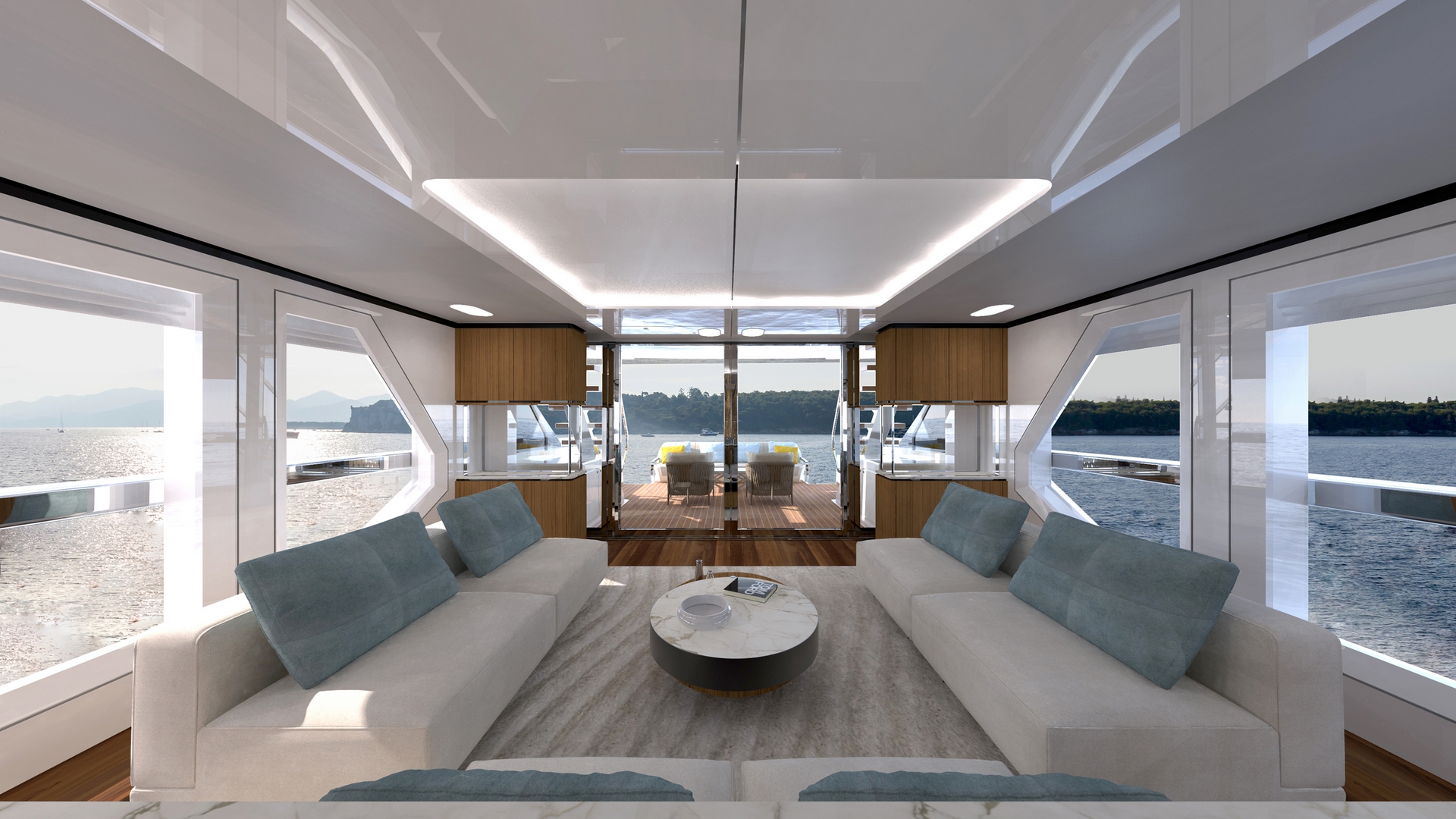
Another example of our commitment to sustainability is our campaign to reduce speeds when sailing close to land, thereby consuming less fuel and protecting the marine environment.
This campaign, launched in 2022 by Amer Yachts and called “Go Slowly”, proposes a maximum sailing speed of 15 knots within 3 nautical miles of the Italian coast. As well as reducing consumption, this will protect the marine habitat, reduce noise pollution and decrease the risk of accidents along this busy coastline.
A total of 29 yachting companies have already signed up to the campaign including Denison Yachting, My Sea, YachtClass and Marina di San Lorenzo, as well as Italy’s representative at the European Commission (EC).
Sustainability is a very complex subject that can be put into practice only through single actions that, together, work sustainably. So, we devised something simple and practical that could be adopted by a large number of pleasure boaters. This also helps us look toward the future, where there will be boating of all kinds, from hybrid to electric, involving vessels that might be a bit slower.
We also have two important projects with Gs4c and Polimi for the development of new sustainable materials. With GS4C, we are replacing fiberglass with the volcanic fibre Filava made by Isomatex, which is composed of enriched volcanic rock and can be recycled indefinitely. Filava is also softer and easier to handle than fibreglass, and has a higher fire resistance. We believe this will set a new standard for sustainable composite manufacturing.
When it comes to classification, we have enjoyed a long relationship with RINA, which now goes far beyond certification. We are proud to have incorporated RINA’s consultant services into our large vessel contracts, and these have been accepted and welcomed by our international clients.
We are also using RINA’s Green Plus additional class notation, which provides an external evaluation of the ship’s environmental friendliness.
RINA has also classified innovative projects such as our Basalt fibre certification, and Amer Yachts 94’s competition for a place in the Guinness Book of World Records as the most efficient motor yacht in its class.
With RINA, we feel like we are part of a family which is working together towards a common goal of increasing efficiency and achieving sustainability.
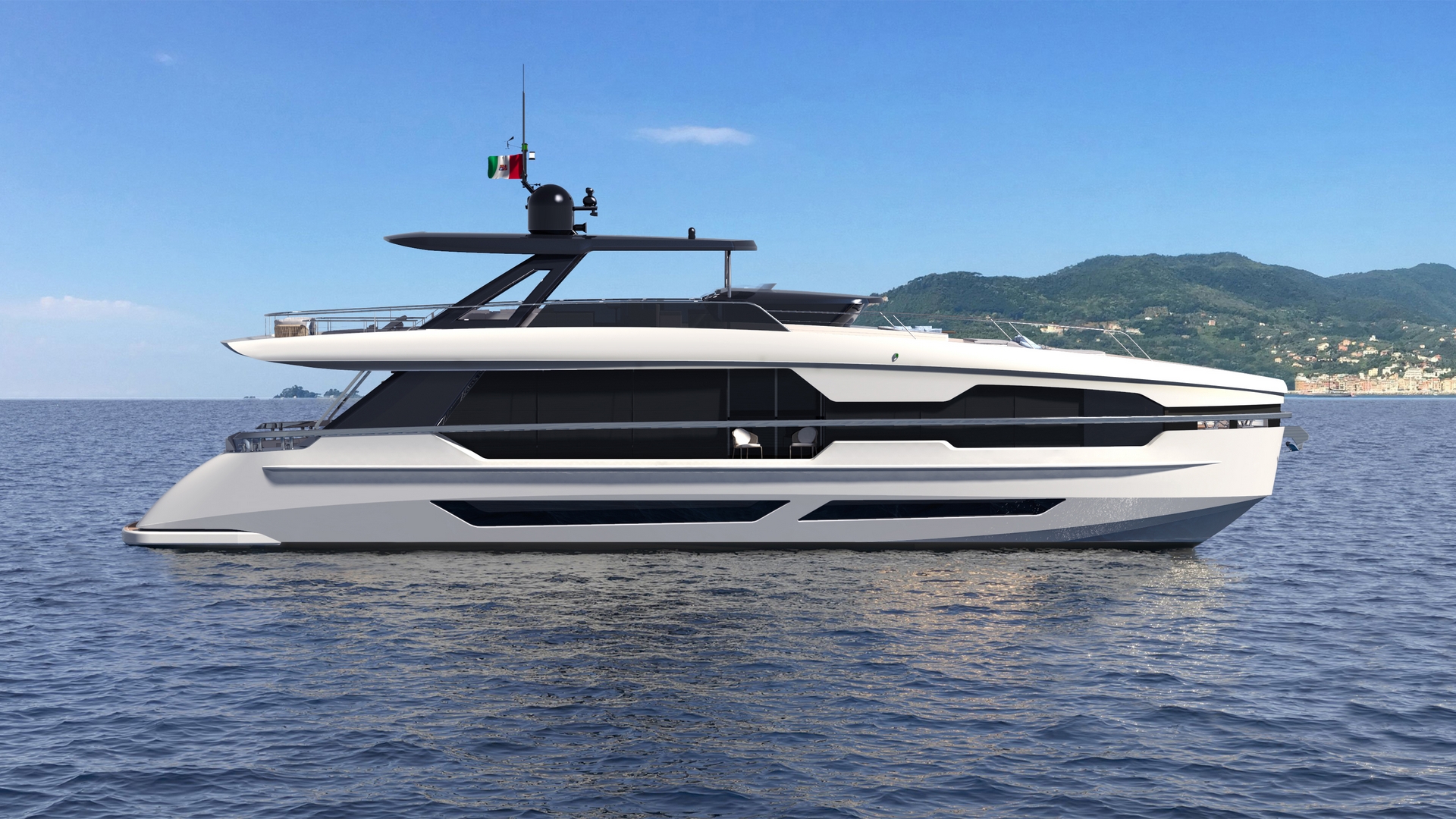
Interview with
Gianpaolo Lapenna, Chief Operating Officer of Palumbo Superyachts

Gianpaolo Lapenna was born in Naples in 1978. He is currently COO of Palumbo Superyachts where he has worked since the Columbus brand was founded and the Superyachts division was launched within the Palumbo Group.
Gianpaolo graduated with honours in Naval Engineering at the University of Naples Federico II in 2005. He then joined the Palumbo Group team as a Project Manager, supervising the construction of two fast aluminium ferries. In 2008, he became Project Manager for the construction of the first 54-metre Columbus yacht and subsequently Head of the Technical Department of the entire Superyachts division, responsible for the group’s new 80-metre flagship.
Today, Gianpaolo, as COO, is responsible for the coordination and optimization of the company’s operational and design activities in order to make them more effective and functional for the business. He heads the technical and R&D teams of the new construction division, which includes internationally-renowned brands such as ISA Yachts, Columbus, Mondomarine and Extra.
Gianpaolo Lapenna is a spearfishing enthusiast as well as a passionate fan of his hometown Naples.
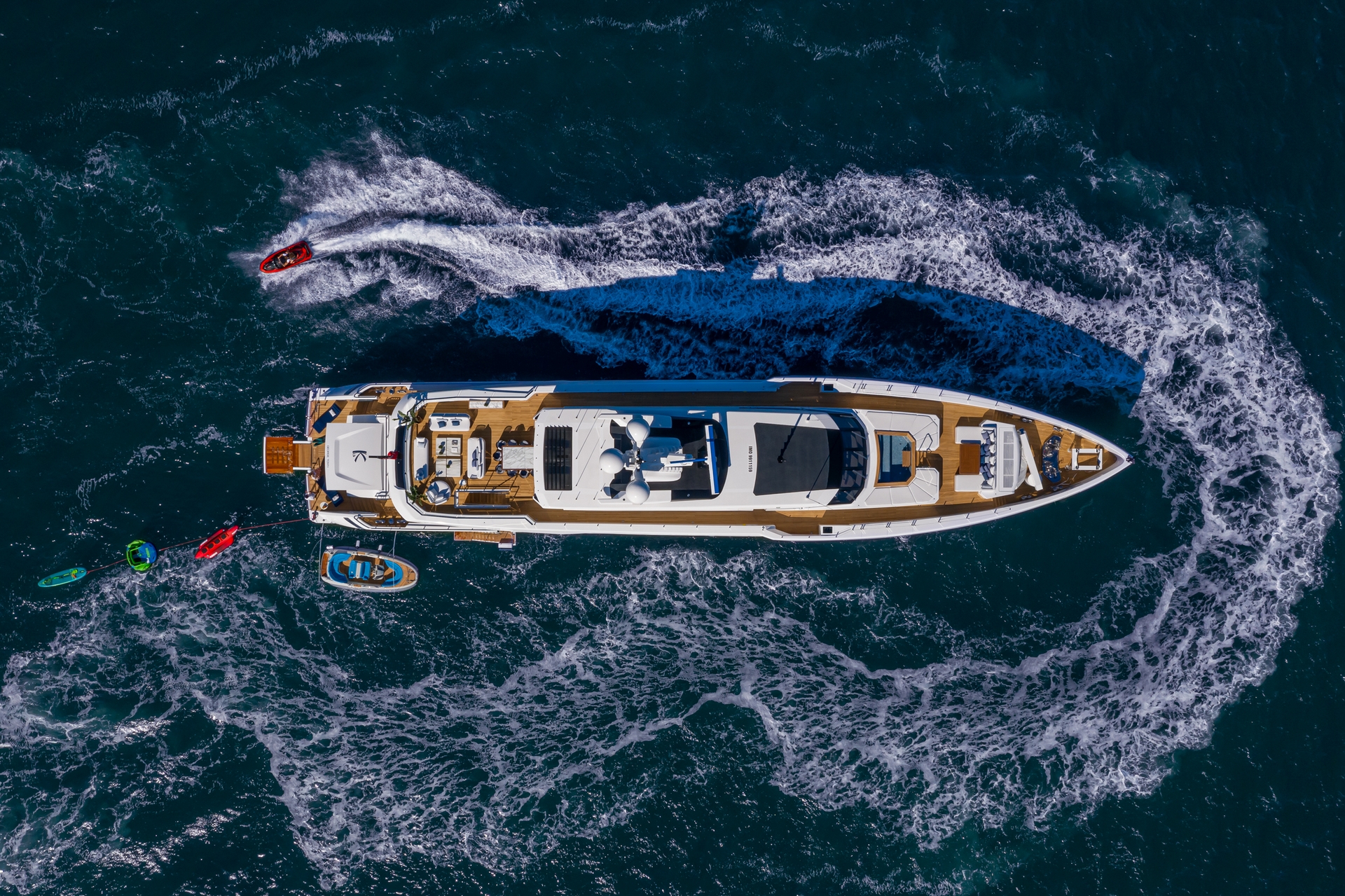
Columbus Sport 50 Metri M/Y K2
Despite the difficulties of the past few years, like many in the industry we remain extremely busy, and are making good progress in achieving our medium-term targets. We are moving to where we want to be, which is firmly into the large yacht market above 500 gt.
Today, more than two-thirds of Palumbo’s orderbook is for superyachts and megayachts, focusing on the 66 metre and 80 metre sizes. This is arguably the most satisfying segment of the yacht market for a shipyard, with big projects where you work with the most famous names in the market. It was always Palumbo’s intention to move into this segment.
In terms of the wider market, activity levels remain extremely high and the medium-term situation for the industry is very positive. We believe this will continue for at least the next three years.
After that, we expect some normalization in the market, where it will likely shake out somewhere between the current situation and that of the market in 2019 when activity was low – we should be somewhere in the middle. Yes, the number of yachts built will be reduced, but owners will be in a position to enjoy shorter construction times!
Elsewhere we are, as always, focusing on new technology and innovations. A revolutionary product in yacht construction has undoubtedly been 3-D design technology, where you are really engineering in ‘real time’. A 3-D scan of yachts under build enables our technicians to finetune all the elements, so that we ‘realise’ the final product before a single element is put in place and before problems can occur.
Technology also plays an important role in the refit business: the two most important elements in refit projects are quality and time, and technology offers new possibilities for both of these. In all our yards we use mobile phone applications now for scanning, for listing appliances, everything. This has significantly increased time efficiency.
The other major area of innovation is of course environmental. Palumbo has been a pioneer in this area, launching a yacht sustainability division as long ago as 2008. At the time, clients were not focused on this element but for us it was inevitable where the market would go.
This specialism was underlined in 2011 when Palumbo was awarded a Green Star Plus Platinum notation for its 54 metre yacht PRIMA. Later in 2014, Palumbo became the first yacht-building shipyard in the world to obtain the “Hybrid Propulsion” (Electric Motor & Shaft Generator) Class Certificate for our 40 metre sport hybrid yacht ELEONORA III, built by the group’s Columbus Yards.
Now, after optimising our yachting products for sustainability, we are introducing procedures to reduce the environmental impact of our onshore yacht building activities.
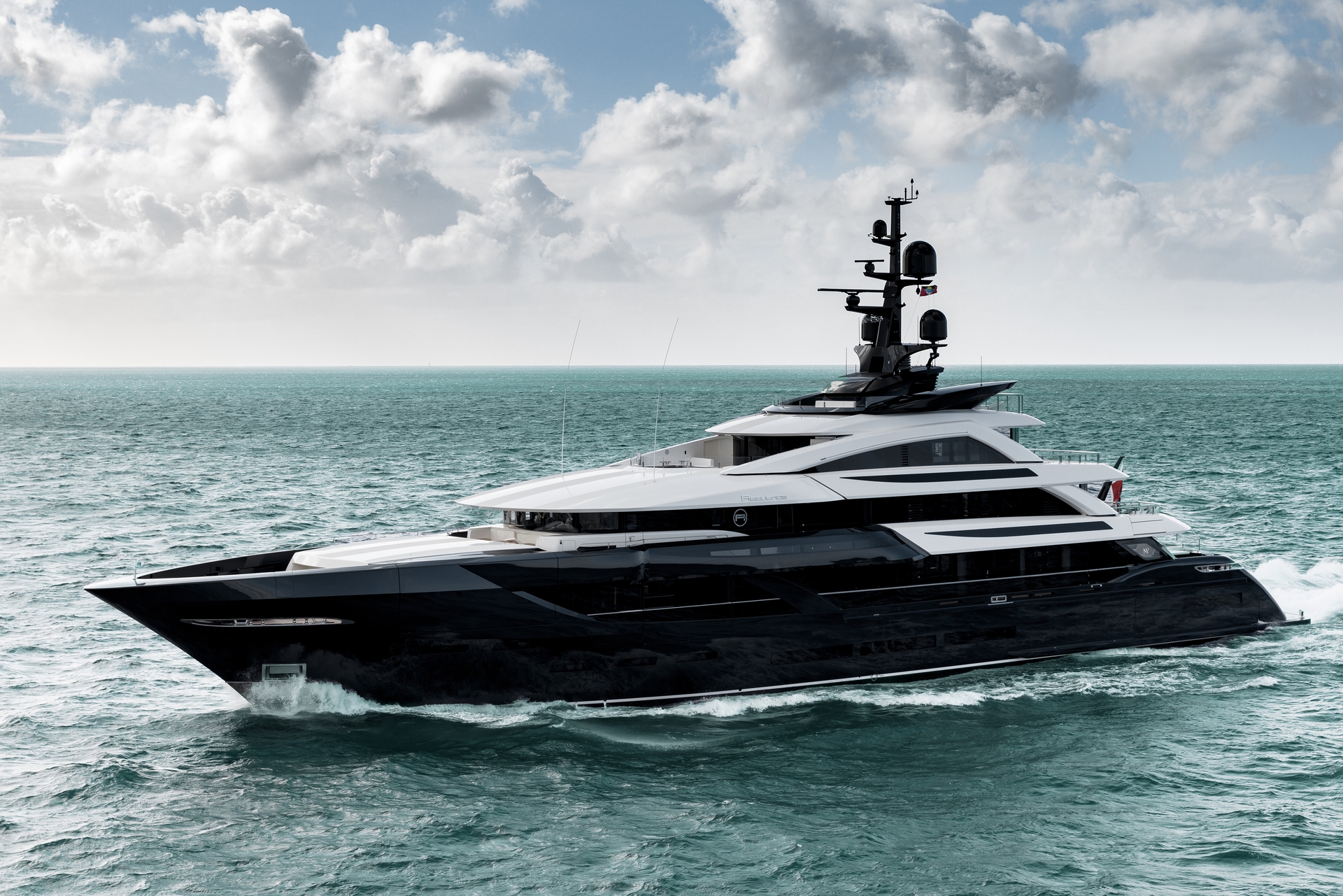
ISA Classic 65 metri M/Y Resilience
Today, hybrid fuel propulsion is automatically discussed in the kick-off meeting. Engine makers are not quite ready to provide combustible fuel engines for current orders but these will be widely available from 2025 onwards.
We also try to reduce overall fuel consumption with smart design. Efficient hull lines became less important when fuel was cheap but Palumbo has always focused on the best hull design to achieve speed at the highest efficiency.
Classification societies play a key role. Our relationship with RINA started over 40 years ago, and today 95% of our projects are supported by RINA, including both new constructions and refit projects. We are very happy with this relationship and always encourage our owners to work with the society.
More recently we have contracted with RINA’s new noise and vibration consultancy and have had extremely good results that are considerably lower than our previous benchmarks. In the case of noise reduction, which is essentially a question of insulation methods, we are always extremely satisfied with the approach which cleanly meld cost and comfort considerations.
Together with RINA we are now working hard to push the industry to adopt more rigorous safety codes. We have seen a surge in demand for new yachts, multiplying the number of boats on the water. Although the majority of crews are skilled and professional, the risk of operational mistakes remains.
As a shipyard, we approach the issue from an engineering viewpoint: a yacht is not a toy, it is a complex piece of engineering that must be handled safely. We must have the best rules and regulations to protect the safety of the yacht and those on board.
Standards for larger yachts above 500 gt are largely satisfactory but there is a need for more regulation in the segment below 500 gt. We hope regulators, administrations and classifications societies will focus on the smaller vessels to improve standards and find a common approach to safety codes.
Interview with
Giovanna Vitelli, Chair of Azimut Benetti S.p.A.

Giovanna Vitelli is the Chair of Azimut Benetti SpA, the largest luxury yachting group in the world, founded by Paolo Vitelli in 1969. Giovanna was born in Turin and graduated with honors in Law from the University of Turin. She began her career at the leading law firm Bonelli Erede Pappalardo, dealing mainly with corporate transactions and mergers and acquisitions.
Giovanna joined the Board of Directors of Azimut Benetti in 2000, and subsequently became Executive Vice President with responsibility for R&D and the development of new models. She was closely involved in the push towards innovative propulsion solutions and the use of designers from beyond the yachting world.
She was appointed Chair of Azimut Benetti in March 2023.
In addition to her role at Azimut Benetti, Giovanna sits on the Board of Directors of several companies including Lusben Varazze Srl, Varazze Marina, Breithorn Srl, and Buzzi Unicem SpA. Giovanna also sits on the executive committee of Boot Messe Düsseldorf, which manages the organization of the Messe Düsseldorf International Boat Show, and is Vice President of Sybass, the international association of large megayacht manufacturers. Since 2018, she is the Honorary Consul of Norway for Piedmont.
From your point of view, what is the short-term and long-term outlook for the nautical sector?
The nautical sector, like many others, faces a fundamental challenge in the short and long term—the ‘green’ transition.
Thanks to my father’s foresight, our Group began investing heavily in research aimed at reducing carbon emissions over twenty years ago. As a result, we stand as one of the few—perhaps the only—boatyards capable of announcing significant milestones in the short term. Under the Azimut brand, we take pride in having over half of our product range comprised of ‘Low Emission Yachts,’ which are yachts consuming more than 20% less than traditional boats of similar size, as of today. How did we achieve this? Three key factors played a role: (i) using lighter construction materials, with carbon fiber being extensively employed on our series boats, whose production we have internalized; (ii) employing hulls with highly hydrodynamic shapes, some of which we have patented for their advanced technology; (iii) efficient propulsion systems. We are also the shipyard with the most advanced hybrid and diesel-electric installations: Benetti’s “Luminosity,” delivered in 2020, holds the title of the world’s largest Hybrid Yacht, and the B.YOND 37M, the first semi-custom hybrid yacht of this size, was recognized as the “Greenest Yacht of the Year” in 2022.
Our next challenge has been channeling all the results achieved and the best technology into a new product range—the Azimut Seadeck. Our ambition is to extend significant fuel consumption reductions across the entire range, thereby making a difference for a larger number of units. The Seadeck series is designed to lower emissions by up to 40% over a year of average use, whether cruising or at anchor, in comparison to a traditional flybridge boat of similar dimensions. This is a challenge for the near future, as we will launch this range in 2024.
In the long term, while we remain passionate about research related to new fuels (methanol and hydrogen), we believe that widespread results will not be achievable for more than a decade, being at first limited to prototype forms, since technology, distribution, production, and storage pose today numerous unresolved questions in our sector, as in others. Therefore, we view the refinement of hybrids and diesel-electrics, even though they are transitional and not definitive solutions, as the most concrete answer in the coming years.
What are the group’s other contributions in the development of a sustainable and environmentally-friendly culture?
The most recent outcome of our “Green Path” commitment to sustainability is our recent agreement with Eni Sustainable Mobility, positioning our Group at the forefront of decarbonizing the yachting industry by introducing HVOlution, a biofuel derived from renewable raw materials. When considering the entire logistics-production chain, the biofuel achieves emission reductions of up to 90% compared to the baseline fossil fuel mix.
Our Group is the first to replace fossil fuels with biofuel in sea trials, technical tests, and prototype transportation. Together with Eni Sustainable Mobility, we are developing a distribution network to enhance accessibility to HVO biofuel.
How does the new owner generation feel about yachting sustainability?
We strongly believe that the future of boating must offer environmentally sustainable solutions and it is our duty to educate and push future generations to embrace them.
For instance, if we look at Benetti’s B.YOND series, more than half of the units sold have been equipped with the “green” option featuring the Siemens hybrid engine. Despite the higher cost associated with this choice, new owners have consistently opted for it. This trend highlights the unwavering commitment of the new generation to sustainability.
Digitalization and new technologies are topics of paramount importance. How will they affect the market?
Thanks to my father’s pioneering vision, our group made significant investments in technology, introducing several revolutionary solutions for the marine industry. Just like our early investment in the pod propulsion system, which is now widely recognized as the best and most efficient system for yachting, or the introduction of the carbon fiber process, industrialized internally in our shipyard, to lighten the yachts.
Augmented reality is another example of technology enhancing production. It contributes to faster, more precise, and efficient design processes. This technology allows for immediate and realistic visualization of spaces, dimensions, and heights. Moreover, new technology is enhancing owners’ on-board experiences by providing advanced electronic solutions that seamlessly connect with their digital devices.
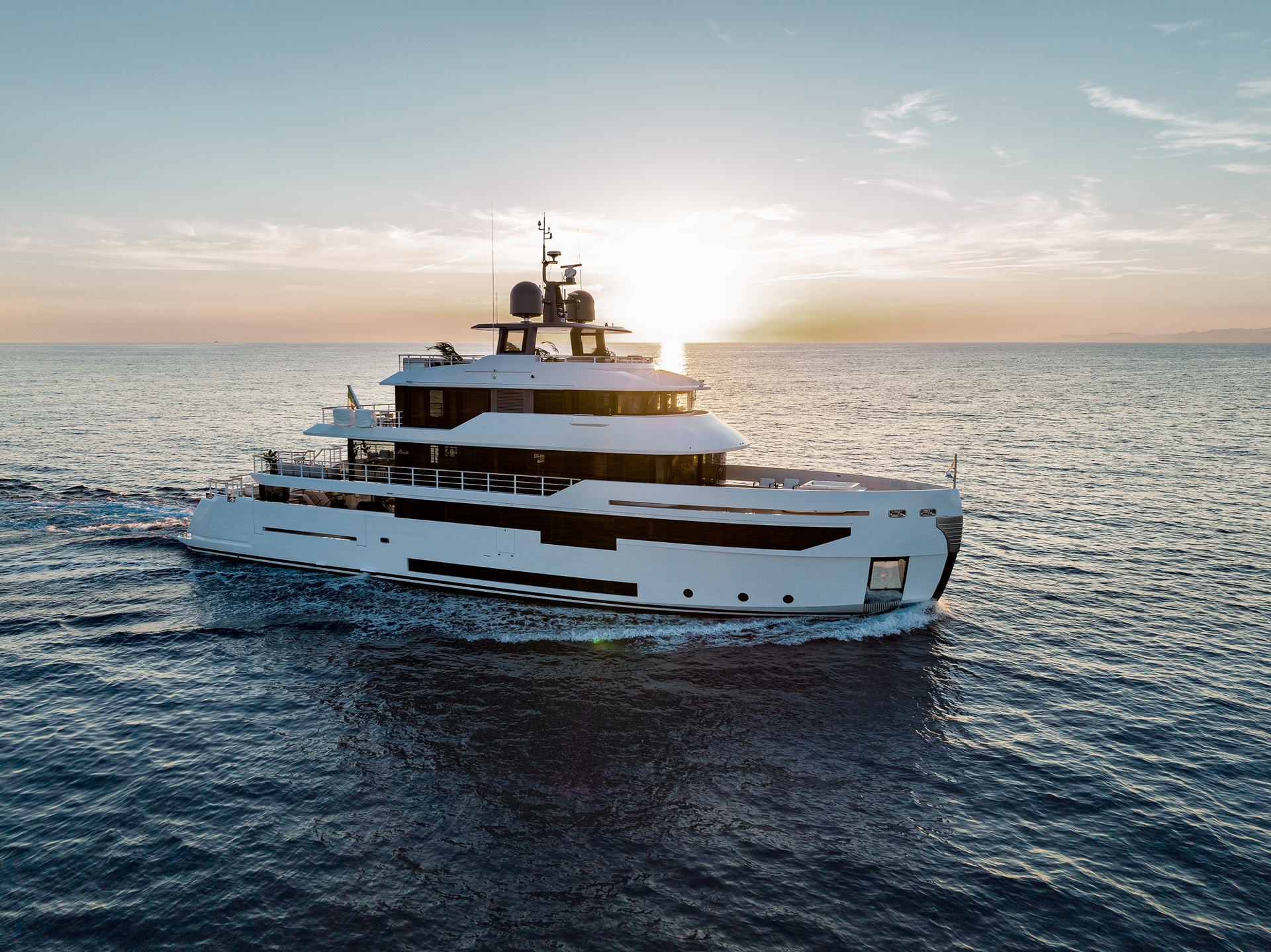
The BNow 50 mt: how will this new style of yachting change life on board?
Our Benetti B.Now yachts, ranging from 50 to 72 meters, showcase innovative design and advanced construction technology. Notably, the “Fantasea,” one of the 18 units sold of the B.Now 50 meters, has been produced in just 10 months.
Designed in collaboration with the UK-based RWD studios, B.Now yachts offer two distinct layout options. The first is quite traditional, while the second incorporates our innovative OASIS DECK®. This option features an infinity pool seamlessly integrated into the flush deck, effectively transforming the design to create a new informal style of living on board. By removing barriers between the main salon and the sea, we have created a vast, multifunctional area dedicated to entertainment, socializing, and relaxation. This design allows for an unparalleled connection with the sea.
What are the main challenges in the refit market, particularly for Lusben?
Lusben, already established as one of the leading refit hubs in the Mediterranean, is now expanding its expertise to large yachts over 100 meters in length. To achieve this ambitious goal, we have strengthened the entire organization, improved the quality of services, and upgraded infrastructure. We expect these improvements to bring new growth and job opportunities.
What is your relationship with RINA and what do you value from this membership?
In many of these projects, RINA has worked closely with us. Our partnership initially centered around ship classification but has evolved into a collaboration in the field of technical innovation.
Currently, we work together as solution providers, addressing various aspects pertaining to energy transition and sustainability. Our cooperation spans activities such as providing green class notations, conducting risk assessments for hybrid systems, and performing comprehensive product life cycle assessments.
Through this collaborative effort, our shared objective is to drive positive change and support the industry’s transition toward a more sustainable future.
